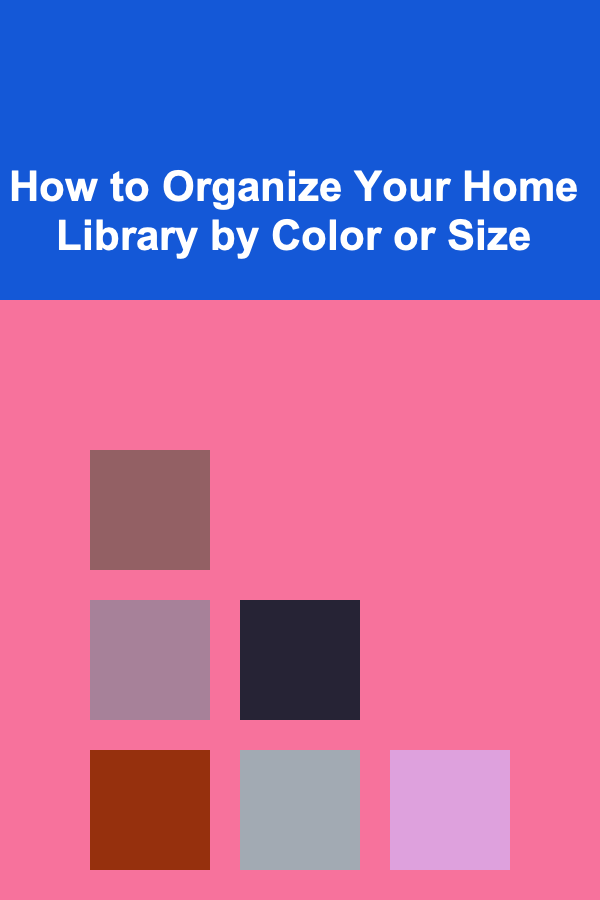
How to Organize Your Home Library by Color or Size
ebook include PDF & Audio bundle (Micro Guide)
$12.99$5.99
Limited Time Offer! Order within the next:

A home library is more than just a collection of books; it is a personal sanctuary, a space for reflection, learning, and escape. As book lovers know, the way you organize your home library can greatly impact your enjoyment and ease of access. Two popular methods of organization are by color and by size. Each method has its own set of benefits and challenges, and the choice ultimately depends on individual taste and needs. This comprehensive guide will explore the principles of organizing your home library by color or size, providing practical steps, tips, and considerations for achieving a beautifully curated space.
The Importance of Organizing Your Home Library
1. Enhanced Aesthetics
An organized library creates a visually appealing space that can serve as a stunning focal point in your home. Whether you choose to organize by color or size, a well-arranged library reflects your personality and style.
2. Improved Accessibility
An effective organization system enhances accessibility, making it easier to locate specific titles or genres. You'll spend less time searching for books and more time enjoying them.
3. Encouragement for Reading
A tidy and inviting library encourages reading. When books are easy to find and visually attractive, you're more likely to pick one up and dive into a new narrative.
4. Personal Reflection
Your library is a representation of your tastes, interests, and personal journey. Organizing your collection allows you to reflect on your reading history and preferences, inspiring future literary adventures.
Organizing by Color
The Concept of Organizing by Color
Organizing your library by color creates a vibrant and artistic display that attracts attention. This method involves grouping books according to their cover colors, resulting in a rainbow effect that can be visually striking.
Benefits of Color Organization
- Visual Appeal: A color-coded library serves as an eye-catching décor element in any room.
- Artistic Expression: It allows for creativity, transforming your library into a personalized art installation.
- Easier Recall: Many readers remember the colors of book covers, making it easier to locate specific titles.
Challenges of Color Organization
- Difficulty in Finding Titles: If you're searching for a specific book and can't recall its color, locating it may become challenging.
- Disruption of Genres: Grouping books by color often disrupts genre organization, which some readers prefer for easy access.
Steps to Organize Your Library by Color
Step 1: Gather Your Books
Collect all your books in one area to assess your entire collection. This process allows you to see what you have and decide what to keep or donate.
Step 2: Sort by Color
Begin sorting your books into piles based on their dominant cover colors. Common categories might include:
- Red
- Orange
- Yellow
- Green
- Blue
- Purple
- Brown
- Black
- White
Step 3: Arrange by Shade
Within each color category, further arrange the books by shade. For instance, light blue books can go before dark blue ones, creating a gradient effect.
Step 4: Choose Your Shelving Layout
Consider how you want to display your books:
- Horizontal Stacking: For a casual look, stack some books horizontally within the vertical rows.
- Vertical Displays: Traditional upright positioning maximizes visibility and access.
Step 5: Implement Labels (Optional)
If you want to retain some organizational structure, consider adding small labels or tags to indicate genres or authors, hidden discreetly among the colors.
Step 6: Maintain Your System
As you acquire new books, integrate them into the color-coded system. Periodically reassess your collection to ensure it remains organized.
Organizing by Size
The Concept of Organizing by Size
Organizing your library by size involves arranging books based on their physical dimensions---grouping tall books together, medium-sized books together, and so on. This approach prioritizes practicality and can create a neat and orderly aesthetic.
Benefits of Size Organization
- Ease of Access: Knowing where books of similar sizes are located makes finding what you're looking for straightforward.
- Efficient Use of Space: Arranging by size allows for optimal use of shelf space, accommodating various heights and widths.
- Genre Cohesion: Often, books of similar genres or topics may also share similar sizes, enhancing thematic displays.
Challenges of Size Organization
- Less Visual Impact: Compared to color organization, arranging by size may appear less visually stimulating or eclectic.
- Potential for Clutter: Without additional organization (such as by genre), size organization may lead to cluttered shelves if not regularly maintained.
Steps to Organize Your Library by Size
Step 1: Assess Your Collection
Start by gathering all your books and assessing their sizes. This will help you identify the range of dimensions you are working with.
Step 2: Categorize by Size
Sort the books into groups based on their sizes:
- Tall (oversized books)
- Medium (standard trade paperbacks and hardcover novels)
- Short (mass-market paperbacks and children's books)
Step 3: Arrange by Size on Shelves
Arrange the categories on your shelves based on height. Place taller books at the top, medium books in the middle, and shorter books at the bottom. Consider the following layout options:
- By Height: All tall books together, followed by medium then short.
- By Genre and Size: Combine size organization with genre for a tailored approach.
Step 4: Add Decorative Items (Optional)
Incorporate decorative items such as plants, frames, or art pieces between books to break up uniformity and add visual interest.
Step 5: Label Your Sections
Label shelves to indicate the size categories, genres, or authors represented on each shelf. This adds clarity and helps with quick access.
Step 6: Regular Maintenance
Monitor your library regularly, especially when acquiring new books. Remove or re-shelve items as necessary to maintain order.
Combining Color and Size Organization
While both methods have their pros and cons, combining them can lead to a harmonious balance of aesthetics and functionality. Here's how to merge these approaches effectively:
1. Choose Primary Criteria
Decide whether you want your primary organizing principle to be color or size. Base this decision on your personal preference and lifestyle.
2. Subcategorize Within the Main Structure
Once your primary criteria are established, apply the secondary organizing method. For example, if you choose to organize by color, you can arrange books of similar shades by size within the color groups.
3. Experiment with Layout
Don't be afraid to experiment with different arrangements until you find a layout that both looks good and feels functional.
4. Be Flexible
Allow yourself the freedom to change your organization system if it stops working for you over time. Flexibility is essential for maintaining an enjoyable reading environment.
Tips for Maintaining Your Organized Library
1. Set a Routine for Updates
Schedule regular reviews of your library to assess whether the organization method still serves you. Consider quarterly check-ins to avoid clutter.
2. Keep Inventory
Maintain a digital or physical inventory of your books. This can be helpful for tracking purchases, donations, or new additions.
3. Create a Donation Plan
Set criteria for donating books you no longer read or need. A good rule of thumb is to let go of books that haven't been touched in over a year.
4. Embrace New Arrivals Wisely
When adding new books, carefully assess how they fit into your existing organization system. Consider whether they mesh with your chosen color or size scheme.
Conclusion
Organizing your home library by color or size can transform it into an inviting and functional space that reflects your personality and encourages reading. Both methods offer unique benefits, allowing you to choose the one that aligns best with your style and lifestyle.
By taking the time to curate your collection thoughtfully and maintaining it diligently, you create not just a library but a sanctuary for exploration, learning, and inspiration. So gather your books, choose your organization method, and embrace the joy of an organized home library!
With these insights, you're ready to take the next step in organizing your reading space. Happy organizing!
Reading More From Our Other Websites
- [Home Budget Decorating 101] How to Style Your Home with Budget-Friendly Decorative Pillows
- [Home Space Saving 101] How to Store Your Seasonal Clothing Without Taking Up Too Much Space
- [Home Holiday Decoration 101] How to Make a Festive Hot Cocoa Bar at Home
- [Organization Tip 101] How to Evaluate Subscription Services and Save Money
- [Organization Tip 101] What Steps Can You Take to Create a Minimalist Home?
- [Whitewater Rafting Tip 101] Eco-Friendly Rafting: Preserving Rivers While Thriving on the Rapids
- [Personal Investment 101] How to Take Advantage of Investment Opportunities During Recessions
- [Personal Care Tips 101] How to Eat Healthy on a Budget
- [Personal Finance Management 101] How to Wisely Manage an Inheritance: Key Steps for Long-Term Financial Success
- [Organization Tip 101] How to Create a Playroom That Encourages Organization

How to Maintain Your Home's Siding for Long-Lasting Protection
Read More
How to Stage Your Home to Sell in a Buyer's Market
Read More
Saving on Pet Care: Affordable Options for Pet Grooming and Vet Care That Work
Read More
How to Understand the Mental Game of Esports
Read More
How to Track Insurance Premium Expenses for Non-Profit Organizations
Read More
10 Tips for Optimizing Power Consumption in Arduino Projects
Read MoreOther Products

How to Maintain Your Home's Siding for Long-Lasting Protection
Read More
How to Stage Your Home to Sell in a Buyer's Market
Read More
Saving on Pet Care: Affordable Options for Pet Grooming and Vet Care That Work
Read More
How to Understand the Mental Game of Esports
Read More
How to Track Insurance Premium Expenses for Non-Profit Organizations
Read More